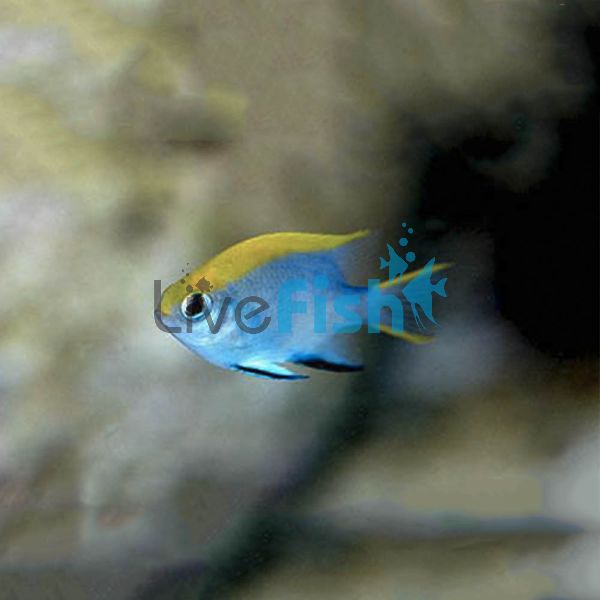Black Damselfish - Medium
As Juveniles these fish have a silver body with a bright yellow dorsal vin and blue pectoral fins. Then as they grow bigger they will change to a solid black colour.
- Buy 4 for $20.02 each and save 10%
As a juveniles thse are very attractive fish with gray bodies highlighted by bright yellow patch. This runs diagonally along the top of it’s body starting at it’s mouth above it’s eye through to the back of it’s dorsal fin and blue pectoral fins. As the fish matures, it becomes uniformly black.
Very small juvenile Black Damselfish are oval in shape with prominent pelvic fins. These are silver in colour with light black lines on the outer edges.
As they grow bigger their dorsal area goes yellow and the pelvic and anal fins go blue with black down the center. This stage of their life is when they are at their most colourful.
Later their body then begins to darken going a dark grey to black colour and the yellow upper body also begins to darken.
Once they are a fully grown adults they are a very dark green to black colour. This is where their name comes from, although the juveniles look very different.
These grow to be one of the larger Damselfish getter to a length of 18cm in the wild.
In aquariums juvenile Black Damselfish are usually peaceful but then gets more aggressive as it grows.
The Black Damselfish is usually seen singularly even as a juvenile. The juveniles tend to be in and around branching corals like the Staghorm coral and stick close to hiding spots. Being fairly colorful they are easy to see and pick out.
The Black Damselfish is very hardy and an excellent choice for "cycling" a new tank.
They live on reef throughout the Indo-West Pacific region
Tank Recommendations for Juvenile Black Damselfish
Black Damselfish are very tough fish and are easy to keep. They can become territorial and may attack other fishes which is usually when as they get older. Whilst they are juveniles they are usually peaceful. Unless you are planning to transfer this fish to a different aquarium as it matures then it is important to ensure they are kept in a large enough tank to accommodate them when they get older.
As juveniles they are like most small reef fish and need plenty of places that they can hide when they feel threatened. Live rock is ideal for this as it can be arranged to create plenty of crevices and hiding places for them whilst also supplying an additional food source from the algae living on it.
Suitable Tank Buddies
As a juvenile you can keep this fish with most other fish, avoiding large predators that can eat it. Unless you are planning on moving it to a different aquarium as it gets bigger then very peaceful fish are likely to be bullied.
So thought should be given as to which fish will be able to cohabit with it once it matures. It should only be kept with other large aggressive species, ideally try to get the fish as juveniles so they can grow in the aquarium together. You should keep only one Black Damselfish in an aquarium, unless it is a very large aquarium. As a juvenile it will be a okay with shrimp, but it’s likely to become a threat to them as it grows and they will also nip at soft corals.
Usually Compatible
Good tank companions for these fish are large Angelfish, larger aggressive Wrasses, Parrotfish, Tangs and Hogfish.
Sometime Compatible
Triggerfish and Rays are usually okay with these Black Damselfish, be careful with Butterflyfish and other Damselfish. When they are juveniles these Damselfish will be fine with the Butterflyfish and other Damselfish, however they may become more aggressive towards them as they mature.
Rarely Compatible
Sharks, Eels, Groupers and Lionfish shouldn’t be kept with these Damselfish as they are just as likely to eat these Damselfish as they are to eat other species of Damselfish.
Seahorses and Pipefish also shouldn’t be kept with them as even if they manage to cohabit with them whilst they are juveniles. Once they get older the Black Damselfish will be far too aggressive to keep with them.
Feeding Your Juvenile Black Damselfish
The Black Damselfish juveniles feed on zooplankton and as they age so they switch to soft corals and the adults feed on soft corals.
In the aquarium the Black Damselfish will accept most foods including flaked and frozen preparations, they aren’t picky eaters. You should also fee them some live foods like brine shrimp, mysis shrimp. When they are small you can feed them copepods too. They will also eat finely chopped fish and will eat algae in the tank too.
| Scientific Name | Neoglyphidodon melas |
|---|---|
| Care Level | Easy |
| Common Names | Bluefin Damselfish is also called the Black Damselfish, Bowtie Damselfish, Yellow-back Damsel, Royal Damsel, Blue-and-Gold Damselfish and Zulu Damsel. |
| Diet | Omnivore |
| Fish Family | Pomacentridae |
| Lifespan (years) | 3 |
| Max. Length (cm) | 18 |
| Min. Tank Volume (l) | 189 |
| Origin | Indo-Pacific |
| Reef Safe | With Caution |
| Sociability | Aggressive |
| Venomous | No |
| Water Conditions | 22.2-25.6° C, dKH 8-12, pH 8.1-8.4, sg 1.020-1.025 |




